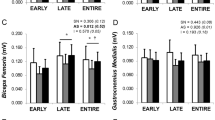Summary
Ground reaction forces and mechanical power were investigated when the subjects walked normally, while they were racing or running at four speeds, and when they performed the running long jump take-off. In addition, the apparent spring constants of the support leg in eccentric and concentric phases were investigated at the four running speeds, during the running long jump take-off, and in the triple jump. Six club level track and field athletes, four national level long jumpers, and six national level triple jumpers took part in the study. Cinematographic technique and a mathematical model of hopping (Alexander and Vernon 1975) were employed in the analysis. Force and power values were found to vary in the following order (from highest to lowest): long jump take-off, maximal running speed, submaximal running (80, 60, and 40% of maximum speed), racing gait, and normal gait. The data disclosed that the measured parameters had the highest values in the long jump take-off performed by the long jump athletes. Their peak values were: resultant ground reaction force 3270±74 N and mechanical power 160.1±10.5 J×kg−1×s−1. For the track and field athletes the values were 2010±80 N and 126.0±12.6 J ×kg−1×s−1. The apparent spring constant values of the support leg in the national level jumper group were in eccentric phase 30.54±8.38 N×mm−1 ×kg−1 and in concentric phase 0.129±0.012 N×mm−1×kg−1. In the track and field athletes the values were 13.97±1.01 N×mm−1×kg−1 and 0.093±0.003 N×mm−1×kg−1, respectively. In general, the increase in force and mechanical power output was related to the value of the apparent spring constant of the support leg in the eccentric phase. The spring constant in the eccentric phase increased with the velocity of motion in running, the long jump take-off and the triple jump. This suggests that it may be possible to use this parameter as a measure of mechanical performance, as it may reflect the combined elasticity of muscles, tendons, and bones.
Similar content being viewed by others
References
Alexander RM, Vernon A (1975) The mechanics of hopping by kangaroos. J Zool 177: 265–303
Asmussen E, Bonde-Petersen F (1974) Storage of elastic energy in skeletal muscles in man. Acta Physiol Scand 91: 385–392
Bosco C, Luhtanen P, Komi PV (1976) Kinetics and kinematics of the take-off in the long jump. In: Komi PV (ed) Biomechanics VB. University Park Press, Baltimore, pp 174–180
Bosco C, Komi PV (1979) Potentiation of the mechanical behavior of the human skeletal muscle through prestretching. Acta Physiol Scand 106: 467–472
Cavagna GA (1970) Elastic bounce of the body. J Appl Physiol 29: 279–282
Cavagna GA, Saibene FB, Margaria R (1963) External work in walking. J Appl Physiol 18: 1–9
Cavagna GA, Saibene FB, Margaria R (1964) Mechanical work in running. J Appl Physiol 19: 249–256
Cavagna GA, Dusman B, Margaria R (1968) Positive work done by a previously stretched muscle. J Appl Physiol 24: 21–32
Cavagna GA, Komarek L, Mazzolini S (1971) The mechanics of sprint running. J Physiol (Lond) 217: 709–721
Cavagna GA, Komarek L, Citterio G, Margaria R (1971) Power output of the previously stretched muscle. In: Vredenbregt J, Wartenweiler J (eds) Medicine and sport, vol 6. Karger, Basel pp 159–167
Dawson TJ, Taylor CR (1973) Energetic cost of locomotion in kangaroos. Nature 246: 313–314
Elftman H (1940) The work done by muscles in running. Am J Physiol 129: 672–684
Fenn WO (1930) Work against gravity and work due to the velocity changes in running. Am J Physiol 93: 433–462
Hill AV (1938) The heat of shortening and the dynamic constants of muscle. Proc R Soc Lond [Biol] 126: 136
Ikai M (1970) Training of muscle strength and power in athletes. FIMS Congress, Oxford
Komi PV, Luhtanen P, Viljamaa K (1974) Measurement of instantaneous contact forces on the force-platform. Research Reports from the Department of Biology of Physical Activity 4/1974, University of JyvÄskylÄ, Finland
Luhtanen P, Komi PV (1978a) Mechanical factors influencing the running speed. In: Asmussen E, Jörgensen K (eds) Biomechanics VIB. University Park Press, Baltimore, pp 23–29
Luhtanen P, Komi PV (1978b) Mechanical energy states during running. Eur J Appl Physiol 38: 41–48
Luhtanen P, Komi PV (1979) Mechanical power and segmental contribution to force impulse in long jump take-off. Eur J Appl Physiol 4: 267–274
Norman R, Sharrat M, Pezzak J, Noble E (1976) Reexamination of the mechanical efficiency of horizontal treadmill running. In: Komi PV (ed) Biomechanics VB. University Park Press, Baltimore, pp 87–93
Wilkie DR (1960) Man as a source of mechanical power. Ergonomics 3: 1–8
Author information
Authors and Affiliations
Rights and permissions
About this article
Cite this article
Luhtanen, P., Komi, P.V. Force-, power-, and elasticity-velocity relationships in walking, running, and jumping. Europ. J. Appl. Physiol. 44, 279–289 (1980). https://doi.org/10.1007/BF00421627
Accepted:
Issue Date:
DOI: https://doi.org/10.1007/BF00421627




